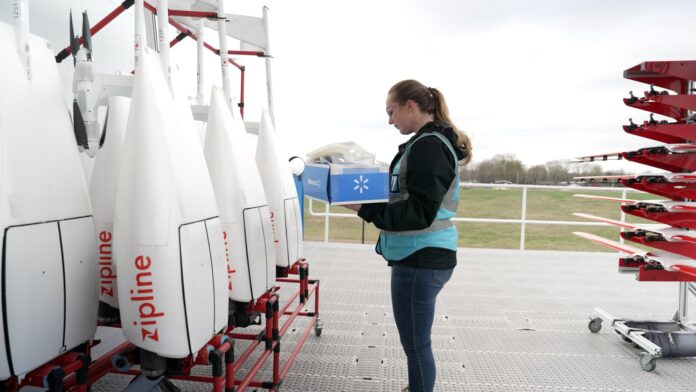Introduction to Zipline’s Drone Delivery Service
Zipline, a startup that delivers a wide range of products via electric autonomous drones, has expanded its service to the Dallas area through a partnership with Walmart. This innovative delivery system allows customers in Mesquite, Texas, to receive their orders within 30 minutes.
How Zipline’s Drone Delivery Works
The company’s newest drones, known as P2 Zips, are capable of carrying up to eight pounds of cargo within a 10-mile radius. These drones can land a package on a space as small as a table or doorstep, making them ideal for home deliveries. The P2 Zips employ lift and cruise propellers and feature a fixed wing that helps them maneuver quietly, even through rain or gusts of wind up to 45 miles per hour.
The Delivery Process
In the delivery process, a P2 Zip will hover around 300 feet above ground level and dispatch a mini-aircraft with a container called the delivery zip. The delivery zip descends on a long tether and moves into place using fan-like thrusters before setting down and allowing package retrieval. Both the P2 Zip and the delivery zip use cameras, other sensors, and Nvidia chips to determine what’s happening in the environment around them and to avoid obstacles while making a delivery.
Expansion and Milestones
Zipline has completed more than 1.5 million deliveries since it began operations in 2016. The company has logged more than 100 million autonomous miles of flight to-date, a number equivalent to flying more than 4,000 loops around the planet. Zipline’s launch in Mesquite comes as the company continues to expand its services in the US. Walmart has completed more than 120,000 drone deliveries to homes since first making the option available through Zipline and other partners in 2021.
Partnerships and Customers
In addition to Walmart, Zipline’s customers include Sweetgreen, Chipotle, and other quick-serve restaurants, as well as health clinics and hospital systems such as Cleveland Clinic and Mayo Clinic. The company initially focused on logistics in healthcare, making deliveries by drone to clinics and hospitals in nations where infrastructure sometimes curtailed timely access to life-saving medicines, blood, vaccines, and personal protective equipment.
Conclusion
Zipline’s drone delivery service is revolutionizing the way we receive our online orders. With its fast and efficient delivery system, the company is making it possible for customers to receive their orders within 30 minutes. As Zipline continues to expand its services, we can expect to see more innovative solutions in the delivery industry. With its strong partnerships and commitment to innovation, Zipline is poised to become a leader in the drone delivery market.

